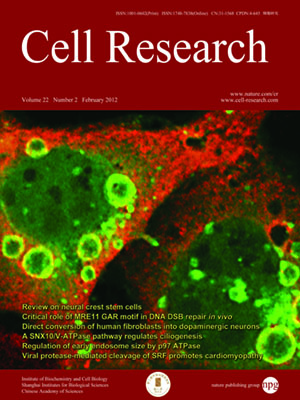
Volume 22, No 2, Feb 2012
ISSN: 1001-0602
EISSN: 1748-7838 2018
impact factor 17.848*
(Clarivate Analytics, 2019)
Volume 22 Issue 2, February 2012: 346-359
ORIGINAL ARTICLES
The p97 ATPase associates with EEA1 to regulate the size of early endosomes
Harish N Ramanathan and Yihong Ye
Laboratory of Molecular Biology, National Institute of Diabetes and Digestive and Kidney Diseases, National Institutes of Health, Bethesda, MD 20892, USA
Correspondence: Yihong Ye,(yihongy@mail.nih.gov)
The AAA (ATPase-associated with various cellular activities) ATPase p97 acts on diverse substrate proteins to partake in various cellular processes such as membrane fusion and endoplasmic reticulum-associated degradation (ERAD). In membrane fusion, p97 is thought to function in analogy to the related ATPase NSF (N-ethylmaleimide-sensitive fusion protein), which promotes membrane fusion by disassembling a SNARE complex. In ERAD, p97 dislocates misfolded proteins from the ER membrane to facilitate their turnover by the proteasome. Here, we identify a novel function of p97 in endocytic trafficking by establishing the early endosomal autoantigen 1 (EEA1) as a new p97 substrate. We demonstrate that a fraction of p97 is localized to the early endosome membrane, where it binds EEA1 via the N-terminal C2H2 zinc finger domain. Inhibition of p97 either by siRNA or a pharmacological inhibitor results in clustering and enlargement of early endosomes, which is associated with an altered trafficking pattern for an endocytic cargo. Mechanistically, we show that p97 inhibition causes increased EEA1 self-association at the endosome membrane. We propose that p97 may regulate the size of early endosomes by governing the oligomeric state of EEA1.
Cell Research (2012) 22:346-359. doi:10.1038/cr.2011.80; published online 10 May 2011
FULL TEXT | PDF
Browse 2137


